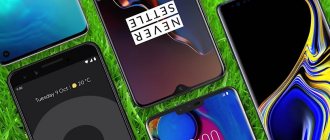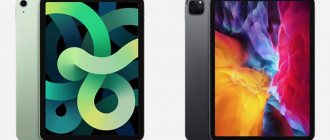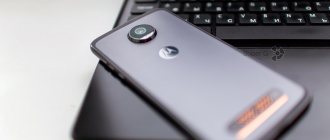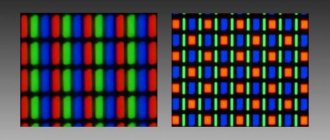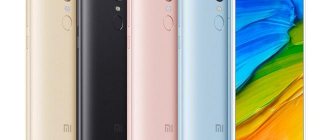At Apple's traditional September presentation, along with the flagships iPhone XS and iPhone XS Max, another iPhone was presented. The model, called XR, has received almost all the key features of the “senior” XS line - but it costs much less.
ON TOPIC: Comparison of iPhone XS and iPhone XR: is the difference significant?
iPhone XR design
The back panel of the iPhone XR is made of tempered glass (which, among other things, allows it to be charged using wireless charging). The frame is made not of surgical steel, like the iPhone X, XS and iPhone XS Mac, but of aluminum, familiar to older iPhones.
Roughly speaking, from the front (screen side) the iPhone XR is a 6.1-inch version of the iPhone X, while the back panel is a larger copy of the iPhone 8.
ON TOPIC: Equalizer: adding bass (low frequencies) when listening to music on iPhone and iPad.
iPhone XR review: screen and sound
The 6.06-inch (excluding roundings at the corners) display of the iPhone XR caused serious indignation among some at the time of its announcement: how is it that a premium phone with a large screen, but the resolution does not even reach FullHD?! Yes, the 1792x828 numbers aren't impressive, but the pixel density per inch here is the same as every compact 4.7-inch iPhone since the iPhone 6: 326 ppi. Without a magnifying glass, it is not possible to distinguish individual pixels; using an iPhone with VR headsets is a rather exotic scenario, so “extra” pixels would only waste battery power.
So what we have here is simply a very high-quality (1400:1 contrast ratio, automatic adjustment of True Tone color temperature, extended P3 color gamut, brightness up to 625 nits), although far from ultra-clear, LCD IPS display. Compared to the OLED screen of the iPhone XS Max, the XR has slightly lower maximum brightness, slightly warmer colors, and the image fades more when viewed from an angle. But during normal use, it is not easy to distinguish the screens of the “older” and “younger” new iPhones, even by displaying the same image on them.
In the two photos above, the brightness of both displays is set to maximum, True Tone, Night Shift and auto-brightness functions are disabled
In terms of characteristics, the LCD display of the iPhone XR is almost identical to the screen of the iPhone 8, but the backlight system has been completely redesigned for a new design in the spirit of the iPhone X. It is because of this that the iPhone XR has a Lightning port offset relative to the middle of the body, and the frames are wider than many Chinese iPhone clones X and at 8.3mm thick is thicker than any iPhone in the last 4 years. It also doesn't have 3D Touch. Instead, you use a long press to quickly turn on the flashlight or camera from the lock screen and some control center items. In order to move the cursor in already typed text, you need to press and hold the space bar on the keyboard. All these actions, as in the case of 3D Touch, are accompanied by a tactile response.
With HDR support on the iPhone XR, things are a little confusing. Formally, it does not have an HDR screen - there is no native support for 10-bit color depth. At the same time, the specifications indicate that the smartphone supports content in HDR10 and Dolby Vision formats. Most likely, 10-bit content is converted to 8-bit, which allows the result on the screen to be as close as possible to the ideal that is only possible on the OLED screens of the iPhone X, XS and XS Max.
Like older models, iPhone XR features updated speakers that play clearly, loudly and create a clear stereo image. When you watch videos on YouTube, play games or listen to podcasts, you don’t feel the need to use headphones, and you can listen to simple music. The set includes regular EarPods with a Lightning connector, but Apple was greedy in this generation of smartphones when putting an adapter for an analog audio connector in the box. However, to output sound from an iPhone to high-quality wired headphones, you still need a preamplifier - even expensive “ears” play very mediocrely through the “dongle” with its cheap digital-to-analog converter.
iPhone XR display
The iPhone XR has a 6.1-inch LCD (not OLED, as in the iPhone X, iPhone XS and iPhone XS Max) screen with a resolution of 1,792 × 828 pixels (326 ppi). It is made using Liquid Retina technology. Apple calls it "our most advanced LCD display yet."
Apple engineers came up with and brought to life a unique “mix” - an edge-to-edge liquid crystal display with curved corners. Thanks to the most modern solutions like True Tone and advanced color rendering, it provides a “live” picture, as if “printed on paper”. In addition, the Cupertino team has ported to the LCD display a previously exclusive function for OLED screens – unlocking with one touch of the screen.
ON TOPIC: Pedometer for iPhone, or how to count steps, distance and calories without buying accessories and applications.
Apple iPhone Xr review: The story of an unfairly slandered iPhone
I read dozens of others before writing this review. They can be easily divided into two categories. In the first, the authors, trying to hype, write that Apple released a color hat that no one needed, which no one would buy for that kind of money. The second category slightly strained praise for the iPhone Xr, declaring it the best iPhone in the world, even better than the Xs and Xs Max. It’s just that you don’t understand anything.
I think it's time to tell the truth about the iPhone Xr.
Let's start with the most important thing - sales. I looked at the statistics of one federal company. You know, the Xr actually sells worse than the Xs Max. Especially in Moscow. Residents of the capital, by all indications, prefer not to indulge in an extra spree at Jean Jacques, but to take the very top spot. But our hero is simply ahead of Xs, and by a large margin.
In other cities of our vast and inexhaustibly rich country, Xr is doing well. I would even say excellent. In some regions, it is simply the best-selling iPhone. At least this is what data for the first half of December 2020 suggests.
The most popular models are black and coral with 128 gigabytes. The (PRODUCT)RED and white versions are a little behind. Blue and yellow ones are not sold at all. It's almost impossible to sell an iPhone Xr with 256 gigabytes on board. They take 64 gigabytes, but, let’s say, without much enthusiasm.
That is, the Russians reacted with considerable interest to the new device and are willing to pay almost 70 thousand rubles for it. Let's look at it carefully and understand why they do this.
Not like everyone else
Some call the iPhone Xr a cheaper version of the Xs, but this, to put it mildly, is not true. Before us is a completely different model, the development of which took almost more effort than the Xs.
Firstly, we have an IPS screen with a unibrow and a diagonal of 6.1 inches . There was nothing like this in Apple devices before. And from an engineering point of view, making such a screen is more than just cutting off a piece of the matrix of the required size and shape. The screen resolution is 1792x828 pixels instead of 2436x1125 on the X/Xs, but you most likely won't notice it. Personally, I noticed when I started writing this paragraph and it was useful to compare the characteristics. I took a closer look - yes, there is a difference. But if you don’t pay attention to it for almost a month, it means that the piece of the matrix was not only cut as it should, but also configured well.
Secondly, this IPS matrix occupies almost the entire surface of the screen . Apple talks about the front-facing display, but compared to the X/Xs/Xs Max, the bezel is still noticeable. Is this annoying? Personally, I don’t. I'm not at all sure that framelessness has absolute value. On my Xr in (PRODUCT)RED it looks like a classic glasses frame. I like classic frames.
Thirdly, the Xr has a completely different body . Both in size and placement of elements. And the materials are different: the Xs has a stainless steel frame, the Xr has an aluminum frame. What is better or worse, I do not presume to judge. Both materials are used in premium smartphones, and, for example, the aluminum frame of the Samsung Galaxy Note9 does not make it a budget device.
Fourthly, it has a different battery design, different from both the iPhone 8 and the iPhone X /Xs . In terms of capacity, it is almost the most capacious among all iPhones - 11.16 Wh (only the Xs Max has more, 12.08 Wh). Combined with the smaller screen diagonal and lower resolution of the latest iPhone Xr, it sets records for longevity among iPhones. In principle, I have not yet been able to drain the Xs Max battery in a day, but I reached the 20% barrier a couple of times. Xr, even at the end of a busy long day, retains 32-37% charge. In terms of longevity, only Huawei flagships and the already mentioned Galaxy Note9 compete with the Xr.
The iPhone Xr battery is second from the left. It seems small in size, but it is significantly thicker than the others
In general, the iPhone Xr is more reminiscent of one of the prototypes of the iPhone X, which they decided to put into production, than a special simplification of the flagships. If the iPhone 5c, with which some experts compare the Xr, really painfully resembled the iPhone 5 in a plastic case, then the Xr is a completely independent product. It's neither good nor bad - it's just the way it is.
Why iPhone Xr ?
You won’t believe it, but the first reason for choosing this particular model is purely... medical in nature. We all love OLED screens for their rich colors, but they have one systemic drawback. OLEDs flicker at low brightness. All. This is due to the use of pulse width modulation to control the lighting of LEDs. Roughly speaking, reduced brightness on OLED is achieved by turning the LEDs on and off. The longer the pause between switching on, the darker the screen appears to the eye.
Most people do not see this flickering at all. But about 20% notice. Most often, flickering is simply annoying. In the iPhone X/Xs/Xs Max, this can be treated in the Universal Access/Display Adaptation/Lower White Point menu, but in some cases this measure does not help. Unfortunately, I personally know a person whose introduction to the iPhone Xs caused dizziness, nausea and a short-term loss of consciousness. And not at all from delight.
For such sensitive users, who number in the millions on the planet, the transition to the iPhone X/Xs is ordered. And Xr, it turns out, is the only modern model that will suit them.
Inside the iPhone Xr is the same processor found in flagship flagships, the A12 Bionic. There are three gigabytes of RAM instead of four, but I think this is not due to the notorious greed of Apple (unifying production would save more than a gigabyte of RAM), but to a lower screen resolution. Is three gigs enough? Well, there’s no point in wasting energy. I didn't notice any difference in performance.
The TrueDepth front camera is simply exactly the same as in the Xs/Xs Max. In addition to this incredibly convenient and simply pleasant facial identification instead of scanning fingerprints, you can take very cool selfies by changing the lighting model after the fact. I have already written about the user experience when identifying the owner by face, but I will not repeat it. Let me just say that without it, the flagship is no longer a flagship.
Taking thoughtful selfies on iPhone Xr is a pleasure
The stereo sound from the built-in speakers is quite decent, there is volume, and detail is at its best. Also, wireless charging and its accelerated wired sister have not gone away when you buy a more powerful power supply (in the box, as usual, there is a regular one).
The dust and moisture protection standard is IP67, that is, up to 30 minutes at a depth of no more than a meter. This is a whole meter (!) less than the Xs, but exactly the same as last year’s iPhone X (I keep thinking about the launch of the once rejected prototype).
In general, by and large, everything here is like in the top models. Except for one limitation. Okay, one and a half.
Why not iPhone Xr ?
Xr does not support 3D Touch technology. Well, when you click on an application icon, and it offers you different options without opening the main window. This looks terribly cool in all sorts of presentations, but in practice I (personally) have never found it useful. If opening an application takes a split second, why these crutches?
The second limitation is more serious: the iPhone Xr has only one main camera module instead of two. He is good. Exactly the same as the main one in the iPhone Xs and Xs Max. But the absence of a second module deprives us of 2x optical zoom and 10x digital zoom. Instead, only digital 5x.
I could console you by saying that we lived with single-module cameras and did not bother. Even the photographs turned out quite good. But zoom is a useful thing. It makes life a lot easier, and it’s not always possible to compensate for its absence by cutting out the desired piece from a photo.
Otherwise, the quality of the images is identical to the flagships, that is, very, very decent. And most importantly - predictable. The video quality was not affected either. I think the new iPhones are simply amazing as a video camera, unencumbered by mediocre lighting or difficult sound imaging. If you like to shoot videos at rock concerts, you will be pleased. The latest videos on my Youtube channel were shot on Xr.
iPhone Xr
iPhone Xs iPhone Xr
iPhone Xs
Portrait mode is fully preserved on the front camera, but on the main one it is emulated in software. Is there a difference? If you photograph people, then no. More precisely, on the iPhone Xr, due to software emulation, it works even more conveniently, because there is no automatic two-fold approach to the subject (on all dual-camera iPhones, the face is filmed using a second module with hardware zoom).
iPhone Xs
iPhone Xr
In general, paradoxically, in some cases, portrait mode on the Xr can produce even better results than on the Xs. But there is a nuance: it only works with faces. This, I’m sure, is an absolutely artificial limitation to emphasize the usefulness of the dual camera on flagships. After all, the iPhone, excuse me, doesn’t really care what object to outline, and a cat is just as suitable for this. Or a dog. Or an electric kettle.
But if you are not a very greedy person, you can purchase the Halide camera application for 299 rubles, which, among other things, can turn on portrait mode on any objects. After this, the only really unpleasant side effect will be the inability to take 3D photos on Facebook. In theory, portrait selfies are completely suitable for this, but apparently Apple agreed with Mark “not to let him in.”
I'll tell you this. If you really take a lot of good photographs with your smartphone, the dual camera module will be of great benefit. And from triple, as in Huawei P20 Pro or Mate 20 Pro, too. But the vast majority of people don’t bother at all about the quality and artistry of their pictures. Just yesterday I watched how one parent was filming a children’s party on an expensive device, holding it vertically, and even tilting the horizon by 25 degrees. The digital zoom, naturally, was turned up to maximum, so that her beloved child was jumping on the screen in the form of a bunch of pixels . And nothing! Everything suited her. We, journalists and bloggers, can talk as much as we want about the importance of a cool camera in a smartphone, but people simply do not know how to use all these wonders. And they don’t really want to study.
Total
At one time, when my iPhone 5s was stolen in Israel, I switched to an iPhone 5c for a while. In principle, it was normal, but the cheerful yellow body reeked of something frivolous, and without a fingerprint scanner it was uncomfortable. At the first opportunity I went back to 5s and, you know, I wasn’t bored.
The iPhone Xr is a different story. Neither the filling, nor the materials, nor the design is inferior to the Xs. Moreover, when showing a person who was not very immersed in the iPhone variety, the Xr was chosen more often. Perhaps because of the luxurious color. But it’s not a fact that it’s only because of him.
If Xr had been equipped with a second photo module at least at the level of the iPhone 8 Plus, it would have been a definite hit. But then the device would begin to eat up sales from the iPhone Xs Max, which is still a little large for the average hand, and the Xr is exactly that. Slightly larger than a regular Xs. Apple, of course, couldn’t allow this to happen, so they simplified the camera.
And here we stand and look at the price tags. If you buy in official retail, the iPhone Xr will cost from 64,990 rubles for the version with 64 gigabytes of memory, and the Xs from 87,990 for the same volume. The difference is 23 thousand rubles. Is the second photo module worth such an additional payment for you personally? If yes, then you will have to fork out some money. If not, Xr becomes the optimal choice. And, judging by its popularity in retail, not all iOS connoisseurs are ready to vote in rubles for a second camera.
In gray retail, prices are lower, but the delta between Xr and Xs remains. But Xr, originally from Hong Kong, has a magical advantage in the form of two physical SIM cards. At first, only the Xs Max had this option, but its price is a little overwhelming even for quite wealthy guys, and many people really liked the appearance of an alternative in the form of the Xr.
Let me not tell you about how I switched to Xr and I consider everyone who didn’t do so to be pretentious suckers. We are quite happy with the dual-SIM Xs Max and do not plan to part ways. However, I really liked the iPhone Xr. By today's Apple standards, it is more or less affordable, but the device does not offend the eyes and hands of a person who can pay a thousand dollars for a smartphone.
Back in 2013, an iPhone 5c with 16 gigabytes of memory cost 25 thousand rubles in Russia. At the same ruble exchange rate, iPhone Xr would cost between 37-38 thousand. Not for a plastic phone with last year's hardware, but for a very modern device made of normal materials, just without some features. Is the price tag reasonable?
It seems to me that the criteria for choosing between Xr and Xs are not in the area of price at all. Only idiots buy phones for such sums with their last money. And where there are 65, there are 87. No, the question here is the user experience and the real requirements for the functionality of the smartphone.
Xr and Xs compete on equal terms.
Tell friends:
- Tweet
- Telegram
iPhone XR does not support 3D Touch
Apple hasn't included 3D Touch support on the iPhone XR screen, which means Peek and Pop gestures (pressing hard on app icons to get action menus and preview content) are no longer available.
Example of how 3D Touch works
At the same time, the smartphone received support for Haptic Touch technology, which works on the principle of a long press, rather than pressing with force, as in 3D Touch. Unfortunately, Haptic Touch on the iPhone XR currently only works in a few places, such as Control Center (for opening additional toggles and menus) and the Lock screen when working with notifications.
Examples of Haptic Touch:
More Haptic Touch gestures will likely be added in future software updates.
ON THE TOPIC: How the iPhone XR and iPhone 8 differ from each other: a detailed comparison.
Communication, sound and autonomy
iPhone XR supports 26 4G bands and two SIM cards. But not like the iPhone XS Max. One physical and a second eSIM are available here, which can be used in Europe, the USA or India; the technology has not yet reached Russia.
You can listen to music through the supplied wired headphones, or via Bluetooth, and AirPods are perfect for this. Bluetooth version 5.0, wide range of supported audio formats: AAC‑LC, HE‑AAC, HE‑AAC v2, protected AAC, MP3, linear PCM, Apple Lossless, FLAC, Dolby Digital (AC‑3), Dolby Digital Plus (E‑ AC‑3) and Audible (formats 2, 3, 4, Audible Enhanced Audio, AAX and AAX+).
But you can still appreciate the maximum sound quality only through a wire, and the sad fact is that there is neither an adapter nor a mini-jack.
On the other hand, there is amazing stereo, where each speaker works individually and sounds really great.
Returning to the question of comparison with the iPhone 8 Plus. With a larger screen, the iPhone XR lasts 1.5 hours longer, while the battery capacity is only 2942 mAh. Wireless charging is 20% faster than iPhone X.
iPhone XR Dimensions
The length of the new smartphone is 150.9 mm, width – 75.7 mm, thickness (depth) – 8.3 mm. Weight – 194 g. Apple notes that the dimensions of the iPhone Xr are the “golden mean” between the sizes of the iPhone 8 and iPhone 8 Plus.
Size comparison between iPhone XR and iPhone 8 Plus
Size comparison between iPhone XR and iPhone 8
Comparison of iPhone XR and iPhone X sizes
Size comparison between iPhone XR and iPhone SE
Design and display
| iPhone XR | iPhone XS | iPhone XS Max | |
| Size | 150.9 x 75.7 x 8.3 mm | 143.6×70.9×7.7 mm | 157.5×77.4×7.7 mm |
| Weight | 194 grams | 177 g | 208 g |
| Display | 6.1″, 1792x828 pixels (HD+), Multi‑Touch LCD display, Liquid Retina HD | 5.8″, 2436×1125 pixels, OLED Multi‑Touch, Super Retina HD | 6.5″, 2688×1242 pixels, OLED Multi‑Touch, Super Retina HD |
| Colors | Yellow, white, coral, black, blue and red | Silver, space gray, gold | Silver, space gray, gold |
In 2020, Apple saw smartphones with larger screens selling well. The 5.8-inch iPhone XS is the smallest phone in the lineup. The 6.5-inch iPhone XS Max is equal to the newer iPhone 11 Pro Max and yet it doesn't feel too big in the hand.
But if you're looking for a design that falls between the two, consider the 6.1-inch iPhone XR. While the XS models come in gold, silver and space gray, the iPhone XR is available in black, blue, coral, red, white and yellow.
Not all iPhone screens are created equal. The 5.8-inch iPhone XS and 6.5-inch XS Max boast bright Super Retina OLED panels, and according to our tests, they're even brighter than the screen on the iPhone X. The 6.1-inch iPhone XR has an LCD -screen.
The iPhone XR's 6.1-inch screen measures 1,792 x 828 pixels, making it less sharp than the Super Retina screens in the 5.8-inch iPhone XS (2,436 x 1,125 pixels) and 6.5-inch iPhone XS Max (2,688 x 1242px), although we doubt you'll notice it at first glance.
However, if your hands prefer a smaller iPhone, you're probably looking at these screens with some disappointment, since the smallest iPhone here (5.8-inch XS) is still quite large for some.
iPhone XR processor
The new generation Apple A12 Bionic CPU is much faster than its predecessor. Two performance cores handle the toughest tasks up to 15% faster than before, and four efficiency cores consume up to 50% less power compared to last year's A11.
And the graphics subsystem works 50% faster than the solution for the iPhone X. It would seem much faster - and yet! Finally, the second generation Neural Engine system processes 5 trillion (!) operations per second. For comparison, just a year ago it performed only 600 million operations. As a result, iPhone Xs will be even faster at handling tasks like recognizing objects in photos, working with augmented reality, etc.
There were also improvements to the graphics. In particular, the iPhone XR received a new 4-core graphics processor with new lossless compression technology. Graphics performance is reported to have increased by up to 50% compared to the A11 Bonic processor.
ON TOPIC: Why is it better to buy an iPhone XR than an iPhone XS: 9 reasons.
Cameras
The biggest difference from the flagship is the camera. The main module consists of just one sensor with a resolution of 12 MP and an aperture of ƒ/1.8. But the camera's portrait mode remains, although it only has three lighting effects, while the iPhone Xs and Xs Max have five. The front camera is still the same - 7 MP with ƒ/2.2 and exactly the same functionality. She is also responsible for Animoji.
Unfortunately, I didn’t have my smartphone for as long as I would have liked, and the weather was a little let down and we didn’t see any sunlight with it. On the other hand, these are quite difficult conditions for the device, when the sky is white all the time. And the iPhone Xr handled it very well. Which, however, is not strange, since the sensor is a flagship one. There is the same Smart HDR, which enhances lighting in the shadows and tries to overcome overexposed areas. The camera also adds a little saturation, but just enough so as not to spoil the picture. Overall, those users who don't turn to a second camera for zoom won't lose anything at all with this model.
Evening photos are also great. The best part is that it's easy to use - all you have to do is take the device out of your pocket, aim and take a photo. With a high degree of probability it will work out the first time.
Using the aforementioned machine learning (for which a separate Neural Engine chip is responsible), the camera takes a portrait photo in several stages. First, she identifies the person (she doesn’t want to perform this “trick” on other objects), then marks the face and estimates the depth. After this, you can adjust the degree of background blur in the finished photo and select lighting effects. The front camera does this using TrueDepth sensors. The task is still difficult, as for a smartphone, but the algorithms do not stand still and the result for the iPhone Xr is very good.
Video recording capabilities are no different from the iPhone Xs. The maximum resolution is 4K with 60 FPS, and slow-motion shooting is carried out in Full HD at 240 frames per second.
Example of 4K video recording:
Example of slow motion video recording:
There are no dramatic changes to the camera app either. Advanced settings, like other manufacturers, have not yet appeared here. True, given the good performance of the automatic mode, nothing more is needed here.
5
ITC.UA rating
Pros: large good screen; beautiful body colors; flagship performance; wireless charging and autonomy
Cons: no headphone adapter included; The power supply does not support fast charging
Conclusion: For some reason, the Xr model was nicknamed the “budget iPhone,” but it is not. In the cheaper model, they saved on the display, case materials and degree of protection from moisture, did not bother with frames around the screen, did not make an option with 512 GB of memory, and there is a little less RAM. All this reduced the cost by a quarter, while all the key features of the smartphone, as well as most of the components, remained the same. We can recommend this model to those who do not use a telephoto camera and do not see the fundamental difference between AMOLED and IPS screens. But before buying, you should twirl the gadget a little in your hands to understand whether such a smartphone will be comfortable to use, because it may turn out to be too big for users with small hands.
Specifications
| Apple iPhone XR 64GB Yellow (MRY72) 13,700 − 24,999 UAH Compare prices | |
| Type | Smartphone |
| Pre-installed OS | iOS |
| RAM, GB | 3 |
| Built-in memory, GB | 64 |
| Expansion slot | — |
| SIM card type | Nano-SIM + eSIM |
| Number of SIM cards | 2 |
| CPU | Apple A12 Bionic |
| Number of Cores | 6 |
| Frequency, GHz | no data |
| Battery | 2942 mAh (non-removable) |
| Diagonal, inches | 6,1 |
| Permission | 1792×828 |
| Matrix type | IPS |
| PPI | 326 |
| Dimming sensor | + |
| Display Features | extended P3 color gamut |
| Main camera, MP | 12 (f/1.9) |
| Video shooting | short-form |
| Flash | + |
| Front camera, MP | 7 (f/2.2) |
| Camera Features | optical stabilization of both cameras |
| WiFi | 802.11ac |
| Bluetooth | + (5.0) |
| GPS | + (GPS, A-GPS, GLONASS, BEIDOU, QZSS, Galileo) |
| IrDA | — |
| FM radio | — |
| Audio jack | — |
| NFC | + (Apple Pay) |
| Interface connector | Apple Lightning |
| Height, mm | 150,9 |
| Width, mm | 75,7 |
| Thickness, mm | 8,3 |
| Weight, g | 194 |
| Protection from dust and moisture | + (IP67) |
| Type of shell | monoblock (non-separable) |
| Housing material | aluminum/glass |
| Keyboard type | screen input |
| More | face scanner (Face ID), support wireless charging, support fast charging |
Face ID on iPhone XR
Apple's proprietary facial recognition system (finally!) began to work even faster. In the iPhone Xr, Face ID will be able to identify the owner even with changes in appearance (with a hat, glasses and a beard). In addition, it replaces all passwords and makes paying via Apple Pay even more convenient: you don’t need to remember anything, just look at the front camera once.
ON TOPIC: 10 cool iPhone + Mac combinations when used together.
Performance
| iPhone XR | iPhone XS | iPhone XS Max | |
| CPU | Apple A12 Bionic (6 cores) + Second generation Neural Engine | Apple A12 Bionic (6 cores) + Second generation Neural Engine | Apple A12 Bionic (6 cores) + Second generation Neural Engine |
| Capacity | 64/128 GB | 64/256/512 GB | 64/256/512 GB |
If fast performance is your top priority, you'll be hard-pressed to find a winner in our iPhone XS vs iPhone XS Max vs iPhone XR showdown, as these phones are equally compelling (except for one aspect). The XR, XS and XS Max are powered by the same A12 bionic processor, the industry's first 7-meter chip (as it beat the Huawei Kirin 980 to market) with 6.9 billion transistors.
The phones are equipped with a 6-core processor, two performance cores and four efficiency cores, and a 4-core GPU.
Apps will launch 30 percent faster than iPhone X and iPhone 8 and feature improved real-time machine learning. You can also expect better AR experiences with 60fps performance and improved low-light performance.
The iPhone XS and XS Max also dominated the Geekbench 4 overall performance test, scoring 11,420 and 11,515 respectively. The XR was very close behind, with 11,312. The Note 9 fell behind with a score of 8,876, while the OnePlus 6 did slightly better, with 9,088. The slightly newer Galaxy S10 Plus, which was the first smartphone to feature Qualcomm's flagship Snapdragon 855 processor, came in at very good 10732.
In other tests, the iPhone XS and XS Max set world speed records. For example, the XS and XS Max transcoded a 2-minute 4K clip to 1080p in 39 seconds, while the OnePlus 6 finished the job in 3 minutes and 45 seconds. Galaxy S10 Plus took 2:26.
Additionally, there is a noticeable difference in loading speeds between the iPhone XR and its more expensive XS/XS Max siblings. Wireless testing found that the iPhone XS and XS Max offered cellular download speeds of 21.7 megabytes per second, while the XR topped download speeds by 17.6 Mbps.
Apple hasn't noted how much memory is in each phone, but iFixit's leak says the iPhone XS and XS Max each have 4GB. Additionally, an Apple research forecast from Ming-Chi Kuo claimed ahead of the launch that the iPhone XS and XS Max will have 4GB of RAM, while the iPhone XR will include 3GB of RAM. This results in faster multitasking and app switching on the iPhone XS compared to the XR.
iPhone XR cameras
This is the second noticeable difference between the iPhone Xr and the Xs line - the main camera here is not double, but single. But the technologies in it are the same as in models with the letter “s”:
SmartHDR – detailed study of light and dark areas in a photo for a clearer picture.
“Bokeh 2.0” – now the background blur is performed even better.
“Depth” – the depth of field is adjusted after shooting.
Improved shooting in low light - because... The pixels became larger, the clarity of the final image increased, and more light began to fall on the matrix.
Capture moving subjects better with SmartHDR and zero shutter lag.
Working with the volumetric characteristics of the frame in portrait mode - as a result, there are many opportunities for experimenting with sharpness and lighting.
All these developments, Apple notes, make selfies on the iPhone Xr noticeably more expressive. The faces in the photo will be clearer, the background will be blurred better, plus you will have the opportunity to “play around” with sharpness at any time and make the photo even more successful.
Video recording has also become better - the iPhone Xr now has the ability to record stereo sound, plus shooting in low light is now even better. Finally, when shooting at up to 30 fps, iOS enables extended dynamic range.
ON TOPIC: How to reduce mobile Internet traffic consumption on iPhone. 13 tips.
Main camera
- 12 MP;
- Aperture f/1.8;
- Video recording in 4K format (up to 60 frames per second);
- Optical image stabilization;
- The camera sensor works 2 times faster.
TrueDepth front camera
- 7 MP;
- Aperture f/2.2;
- Video recording in 1080p (up to 60 frames per second).
Examples of photos taken on iPhone XR
ON TOPIC: 8 reasons to buy an iPhone 7 rather than an iPhone XS, iPhone XS Max or iPhone XR.
Featured camera
Friends are indignant that the iPhone XR has a single camera and there is no second module, although some have already released phones with three or even four main cameras.
New! Samsung Galaxy A9: 4 main cameras and Snapdragon 660 for 40 thousand
Ilya Kichaev
11 October 2018
What can I say, well done, but happiness is not in quantity. I love the iPhone XR's camera design. It is more interesting: the camera looks neater, just like on the iPhone 7 or 8.
At the same time, in terms of characteristics, the camera is the same as in the iPhone XS: the same 12 megapixels and high-quality optics with optical stabilization. And although there is no second lens, the portrait mode works.
Only it is not an additional module that helps him in this, but software. You don’t have to look far for an example - Google took the same route a year ago with its Pixel 2. An important point: the software on iOS works exclusively with human faces, so you won’t be able to make bokeh with your favorite cat.
You can play with the depth of field and “blur” the background after you’ve taken the photo. The function has long been familiar from Android devices, Apple appreciated it, brought it to fruition and added it to iOS. Thanks, it works well.
The phone takes portraits decently, then we’ll take more photos and make a comparison. For now, I will say that the difference compared to the iPhone XS is noticeable: the older model is ahead, but adjusted for the difference in prices, this is normal.
I think that everyone will like the camera - stereo sound for video recording has appeared here, just like in the iPhone XS. For complete happiness, perhaps a 2x optical zoom is not enough, but from my own experience I can say that I rarely use it and would not worry too much about this.
Dual SIM (two-SIM version of iPhone XR)
Yes, yes - in its eleventh year of life, the iPhone finally got a second SIM card! It will be electronic (eSIM) everywhere except China - this technology is prohibited there, and Apple made a version with two “regular” SIM cards especially for the Chinese.
ON THE TOPIC: Hidden features of the iPhone: 25 iOS functions that you might not know about.
Camera. It's better, although without optical zoom
If the nominal number of “eyes” is important to you, then alas. The iPhone XR actually has one module less than the “ten”.
If the quality of photos and videos is important to you, you will be surprised just as I was surprised: the camera in the iPhone XR takes excellent photographs and shoots video in 4K.
I have already tested the camera of this smartphone, and among the pictures I inserted one frame taken on the iPhone X. You can look at the comments and make sure that no one guessed which picture was taken on the iPhone X and not on the iPhone XR.
iPhone XR is waterproof and weatherproof
The new iPhone is protected from water according to the IP67 standard (immersion in water to a depth of 1 meter for up to 30 minutes). Apple also notes that the smartphone is not afraid of an accidental “shower” of beer, juice, salt or regular water, etc.
ON TOPIC: How to set any ringtone on any iPhone without a computer?
Interesting design
If you read what they write about the phone on the Internet, then essentially all complaints about the appearance of the iPhone XR come down to its thick black frames around the screen. Okay, the frames are thick. What's next, what else can you complain about?
And there is no more negativity. The phone has multi-colored glass bodies and a durable aluminum frame on the sides. The cheerful colors are simply a delight for the eyes: you look and admire the bright colors.
I really like the iPhone XR in yellow and blue, the coral looks nice - an interesting color. Too bad it's not orange. But the “bloody” red Product Red didn’t really catch my attention: it looks a bit gloomy. Black is completely boring, and white is not bad, but somehow ordinary. Therefore, I would choose between blue and yellow - the most original colors from Apple this season.
The result is the most cheerful iPhone of all time. And let them say that over time, bright colors become boring. No, I don't agree with this. They don’t get boring, but on the contrary, you are glad that you chose such an elegant thing that it’s a pity to hide in a case.
The body is heavy. The phone is not ultra-light, but rather weighty enough that you can use the well-worn “pleasant heaviness” template to describe the feeling. Rounded sides, smooth transitions of the round screen flowing into the body - you don’t want to part with the phone. It doesn't feel budget or cheap, it's a well-built and enjoyable model.
This can be said about any iPhone, but when you read an opinion on the Internet that the XR is cheap, and Apple is simply profiting from unhappy users, then just go to the store. Take the phone in your hand, try it out, and then draw your own conclusions. I think you will like the phone.
Package contents (what's in the box) iPhone XR
Unfortunately, Apple did not include fast charging in the new iPhones this year either. In addition, we can note the absence of the Lightning to 3.5 mm audio adapter that Apple included in iPhone boxes in past years.
ON TOPIC: How to check whether you bought a new iPhone (activated or not)?
Appearance and equipment
Appearance is one of the main differences between the iPhone XR. First of all, there is a variety of colors that we haven’t seen since the iPhone 5C. The second is the thick frames around the screen. The latter is the most repulsive; it’s the IPS matrix that’s to blame; it doesn’t allow for smaller frames, unlike OLED.
At the presentation, the device was compared with the iPhone 8 Plus - with smaller dimensions, the screen is larger, but there is only one camera. However, the iPhone XR is worth considering if you're looking to get the 7 or 8 Plus.
The smartphone lies confidently in the hand and the thickness of the frames does not bother you at all, especially after the iPhone with 16 x 9 screens. It is noticeably heavier than its competitors (almost 200 grams) and I would attribute this more to positive features, because the race for thickness and weight is of no use does not lead to good things. This smartphone will definitely not bend in your back pocket or slip out of your hand.
The frame is aluminum, the front protective glass is as durable as the iPhone XS, the back has seven layers of glass, the strength is comparable to the iPhone X. The power button is on the right, below is the nano-SIM slot, the volume rocker and mode switch are on the left. The signature cutout in the screen has not gone away. There is protection against dust and moisture according to the IP67 standard, and can be immersed in water for up to half an hour.
iPhone XR includes: EarPods with Lightning input, Lightning to USB cable, and power adapter. There is no adapter from Lightning to mini-jack, as is the case with all iPhones released after September 2020.
iPhone XR price
The 64 GB version will cost 64,990 rubles. The option with 128 GB of internal memory is priced at 68,990 rubles. Finally, the top-end 256 GB modification is offered for 77,990 rubles.
... The iPhone XR has every chance of becoming a real bestseller - its relatively low price speaks in its favor (65,000 rubles versus 88,000 for the iPhone Xs and 97,000 for the iPhone Xs Max), and the presence of almost all the functions of the “older” models, and a large number of interesting colors.
See also:
- How to charge your iPhone faster: 5 basic rules.
- How to enable 4G LTE on iPhone and how does the speed differ depending on the model?
- How to download books to iPhone and iPad for free and without a computer.
October 26, 2020 Tags: iPhone XR, Apple News, iPhone News.
Comments for the site
Cackl e
What is inside
A very important point: the iPhone XR received the same latest Apple A12 processor as the iPhone XS and XS Max. That is, you get the best hardware available today, a wonderful 7nm processor and the confidence that you will receive regular updates for your smartphone. It will serve you for a long time; in the fall, Apple even updated oldies like the iPhone 5s from five years ago to a new version of iOS. So these are not empty words.
The phone can have 64, 128 or 256 GB of internal memory. By the way, it’s very cool that there is a 128 GB version - this is the golden mean, 64 GB may not be enough, and 256 GB is not always possible. But 128 GB is just right, it’s even a shame that the iPhone XS doesn’t have such a volume.
We have already written about the quest with calculating the operating time of the phone.
The exact battery capacity of the iPhone XS, XS Max and XR is known
Vyacheslav Lazarev
September 20, 2018
In short, the iPhone XR is one of the company's longest-lasting phones. I have not been with him for long and cannot yet give an unambiguous conclusion. But I’ll shout again that it’s a shame to include a low-power power supply from the iPhone 5s era with your phone.
Yes, both fast charging and wireless charging work here, but you have to pay for the pleasure and buy a higher-power unit so that the simple charging process does not last forever.
For comparison, OPPO Find X for the same money is fully charged in 40 minutes. Yes, this is not an iPhone, but the speed is amazing. And fast charging included.
Review of the outlandish OPPO Find X
Alexander Pobyvanets
October 22, 2018

